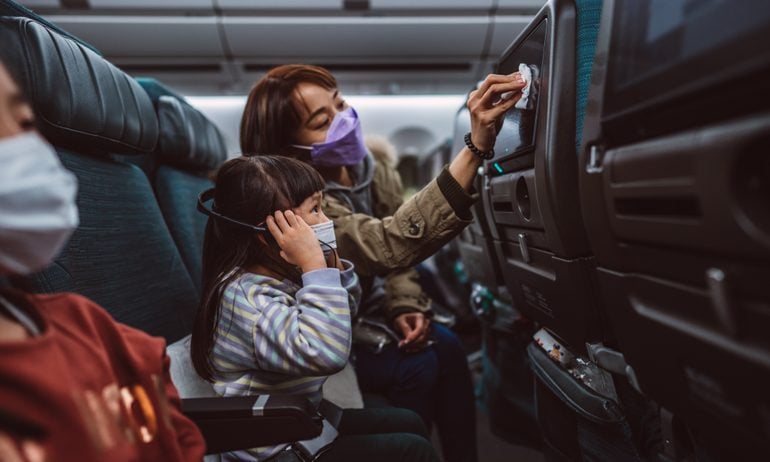Why Don’t We Know If People Are Getting COVID on Planes?
With all the energy devoted to air travel and COVID safety, you'd think we'd have some hard data. We don't.

Many or all of the products on this page are from partners who compensate us when you click to or take an action on their website, but this does not influence our evaluations or ratings. Our opinions are our own.
It seems like all my friends got COVID this summer, and many think they got it on a plane. But that’s as anecdotal as data gets. What does, you know, science have to say?
I talked to Arnold Barnett, a professor of statistics at the Massachusetts Institute of Technology, who co-wrote a recent paper that modeled the risk of contracting COVID while flying early in the pandemic. He and his student combed through the available data and built a complex mathematical model to determine the risk of getting infected onboard. Yet they ran into limitations, because no organized effort was made by the U.S. or any country to systematically contact trace COVID transmissions onboard aircraft.
“Nobody is screened. Nobody is asked if they’ve come down with COVID,” he explains. “There was no attempt made to figure out where people got it. We have so little data.”
That’s right, of all the billions spent combating the virus, supplying at-home testing kits and bailing out the airlines, little to none of it was spent answering the basic question of where and how people actually contracted the disease in the first place. Models like Barnett’s, while helpful, offer only best guesses.
“If we had actual data from the United States, then maybe we wouldn’t have needed a model,” he says.
One systematic attempt to contact trace on a flight that landed in Vietnam found that, of the 16 passengers who tested positive, 12 were in business class, where the one symptomatic case was found. In other words, a bunch of high-price ticket holders at the front of the plane got sick from the same person.
Yet this study from Vietnam's National Institute of Hygiene and Epidemiology was performed in March 2020. Think of what could have happened if we had kept collecting data throughout the pandemic.
Unknown unknowns
Cast your mind back to fall 2020. The first COVID wave had passed and would-be travelers were wondering: Is it safe to fly home for the holidays?
The Centers for Disease Control and Prevention, based on a bizarre study commissioned by many federal agencies involving mannequins coughing at one another, suggested that “most viruses and other germs do not spread easily on flights because of how air circulates and is filtered on airplanes.”
You may remember that study. You may not know (as I didn’t, until recently) that the researchers who performed it received so much criticism that they appended a disclaimer, suggesting the study’s findings “were not designed to provide actionable information about viral risk during flight, safe flight times or seating capacity.”
The CDC has removed its messaging and references to the study, while airlines such as United Airlines continue to cite it as evidence of air travel safety.
The United Airlines website still mentions the problematic study.

I was writing about all this in 2020, trying to parse these confusing messages, and I used the mannequin study as evidence that flying wasn’t as dangerous as we originally thought.
Turns out I was wrong, but never even learned I was wrong until years later.
The real problem isn’t one poorly interpreted study. It’s that we still don’t know the rate at which people contracted (and died from) COVID after getting on a plane. Were 1% of COVID cases caused by air travel? Or 10%? More?
We have no idea, and that could have major ramifications down the road.
Flying into the unknown
Barnett’s model spit out a nice round number, suggesting the odds of contracting COVID on a full two-hour flight were about 1 in 1,000 at the beginning of the pandemic. But he believes the risks have probably increased significantly since then.
“Omicron BA.5 is a lot more contagious than the earlier versions," Barnett says. "And now people by and large are not wearing masks on airplanes.”
Thankfully, vaccines and treatments have reduced the mortality rate of COVID, so the risks are more manageable. But what if a new variant emerges that — knock on wood — evades vaccines altogether? Or (no, really, knock on wood) causes serious illness in young people or children? We will all want a real answer to simple questions: How bad is COVID transmission on planes? Is any one airline safer than another?
Maddeningly, bafflingly, head-scratchingly, we still don’t know for sure.
“All models are wrong, some are useful,” Barnett says with a wry grin.
Chase Sapphire Preferred® Card
Travel
Dining
🔥 Huge highest-ever bonus on NerdWallet's 2025 Best All-Purpose Travel Rewards Card is back. Don't miss your rare chance to: Earn 100,000 points when you spend $5,000 on purchases in the first three months. That's worth at least $1,250 toward travel booked through Chase.


